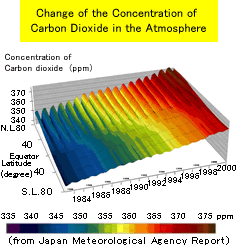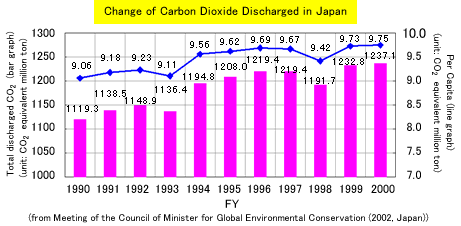![]()
Let's stop global warming by working hand in hand!
The global warming is a serious issue. Its main cause is the emission of carbon dioxide into the atmosphere. Carbon dioxide constitutes 92.9% of the total volume of greenhouse gas emission in Japan alone, the amount discharged per capita exceeding 9 t/year. Because the atmospheric carbon dioxide concentration continues to increase, its reduction is urgent and must be tackled immediately by the actions of peoples world-wide.
 |
|
 |
|
Absorption of atmospheric carbon dioxide by plants, particularly trees, is vital for the reliable fixation of carbon dioxide. To grow, trees use photosynthesis, in which water and atmospheric carbon dioxide are synthesized into carbohydrates. Moreover, carbon dioxide is fixed as cellulose, in which form it remains for long periods in trees. For example, the carbon dioxide accumulated in a teak tree with a trunk diameter of 10cm is 40-50kg, and in one with a diameter of 50cm it is about 5-6 metric tons.
| Amount of CO2 Fixation per whole life of Teak | ||||
|---|---|---|---|---|
| Diameter (cm) |
Height (m) |
Amount of CO2 Fixation per Teak (kg / life) |
Amount of CO2 Fixation per 1 ha of Teak (625 Teaks / ha) (t / life) |
Average amount of CO2 Fixation per 1 ha (625 Teaks / ha) (t / life) |
| 2 | 2-2 | 0.8 | 0.5 | 0.5 |
| 3 | 2-2 | 1.8 | 1.1 | 1.1 |
| 4 | 3-3 | 4.8 | 3.0 | 3.0 |
| 5 | 3-3 | 7.5 | 4.7 | 4.7 |
| 10 | 4-5 | 40-50 | 20-30 | 25 |
| 15 | 6-7 | 130-150 | 190-240 | 85 |
| 20 | 8-10 | 310-390 | 380-500 | 215 |
| 25 | 10-13 | 620-800 | 670-890 | 440 |
| 30 | 12-16 | 1000-1400 | 1500-2000 | 780 |
| 40 | 16-21 | 2500-3300 | 3100-3800 | 1750 |
| 50 | 20-25 | 4900-6200 | 40-50 | 3450 |
Forests of the world, especially those in the tropical regions of Southeast Asia, Africa, and South America, are decreasing at an alarming rate, mainly because of large-scale tree felling and slash-and-burn agriculture. Once trees have been destroyed, the topsoil erodes, and forestlands become wastelands.
It is imperative that we regenerate forests to preserve natural environments in addition to stopping global warming. TGG therefore has taken the initiative of planting trees in order to restore forests in Southeast Asia.
 |
 |
| Teak Sapling Prepared from Cutting by TGG02 for Reforestation |
Clones Prepared from 1500-year-old Teak Cutting |
It is essential to promote the generation and growth of the root, one of the most important plant organs, in order to produce saplings from cuttings. TGG has developed the novel hormones TGG01 and TGG02 which promote strong root formation on tree cuttings and has established an efficient method of their use in the mass production of saplings for reforestation. This method enables us to generate a large number of saplings and carry out large-scale reforestation.
 |
 |
| Teak Sapling Rooted by TGG02 ( Rooting Rate: ~100% ) |
Mass Production of Teak Saplings by Using TGG01 & TGG02 |
The period after which the trees planted in our project will be cut is more than twice that generally used by other enterprises in current reforestation projects. The amount of carbon dioxide fixed by and accumulated in reforested trees increases with time, but if trees are cut after a short growth period sufficient carbon dioxide fixation and accumulation do not occur.
We define reforestation as the regeneration of forests that provide the optimum absorption of carbon dioxide and accumulation as carbohydrates. We therefore sponsor long-term reforestation projects in order to reduce atmospheric carbon dioxide by storage in trees.
Reforestation promotes preservation of the environment and provides economic aid to indigenous peoples. This is done by employing local people to manage reforestation plots and by returning to the country the profits from selling mature teak to the country. Furthermore, means are proposed by which local people get income by carrying out reforestation.
If they can obtain monetary profits by supporting reforestation, then unnecessary destruction of restored forests and harmful slash-and burn agriculture can be prevented. In this way, forests generated by reforestation projects will both protect the environment and enrich the lives of native peoples.